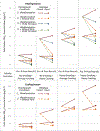Modeling the resiliency of energy-efficient retrofits in low-income multifamily housing
- PMID: 29280511
- PMCID: PMC6386461
- DOI: 10.1111/ina.12446
Modeling the resiliency of energy-efficient retrofits in low-income multifamily housing
Abstract
Residential energy efficiency and ventilation retrofits (eg, building weatherization, local exhaust ventilation, HVAC filtration) can influence indoor air quality (IAQ) and occupant health, but these measures' impact varies by occupant activity. In this study, we used the multizone airflow and IAQ analysis program CONTAM to simulate the impacts of energy retrofits on indoor concentrations of PM2.5 and NO2 in a low-income multifamily housing complex in Boston, Massachusetts (USA). We evaluated the differential impact of residential activities, such as low- and high-emission cooking, cigarette smoking, and window opening, on IAQ across two seasons. We found that a comprehensive package of energy and ventilation retrofits was resilient to a range of occupant activities, while less holistic approaches without ventilation improvements led to increases in indoor PM2.5 or NO2 for some populations. In general, homes with simulated concentration increases included those with heavy cooking and no local exhaust ventilation, and smoking homes without HVAC filtration. Our analytical framework can be used to identify energy-efficient home interventions with indoor retrofit resiliency (ie, those that provide IAQ benefits regardless of occupant activity), as well as less resilient retrofits that can be coupled with behavioral interventions (eg, smoking cessation) to provide cost-effective, widespread benefits.
Keywords: CONTAM; building simulation; energy-efficient retrofits; healthy housing; indoor air quality; indoor retrofit resiliency; multifamily housing.
© 2017 John Wiley & Sons A/S. Published by John Wiley & Sons Ltd.
Figures




Similar articles
-
Quantifying the impact of housing interventions on indoor air quality and energy consumption using coupled simulation models.J Expo Sci Environ Epidemiol. 2020 May;30(3):436-447. doi: 10.1038/s41370-019-0197-3. Epub 2020 Jan 20. J Expo Sci Environ Epidemiol. 2020. PMID: 31959901 Free PMC article.
-
Effects of energy retrofits on Indoor Air Quality in multifamily buildings.Indoor Air. 2019 Jul;29(4):686-697. doi: 10.1111/ina.12555. Epub 2019 Apr 17. Indoor Air. 2019. PMID: 30921480
-
Simulating indoor concentrations of NO(2) and PM(2.5) in multifamily housing for use in health-based intervention modeling.Indoor Air. 2012 Feb;22(1):12-23. doi: 10.1111/j.1600-0668.2011.00742.x. Epub 2011 Oct 20. Indoor Air. 2012. PMID: 21913994 Free PMC article.
-
Indoor Exposure to Selected Air Pollutants in the Home Environment: A Systematic Review.Int J Environ Res Public Health. 2020 Dec 2;17(23):8972. doi: 10.3390/ijerph17238972. Int J Environ Res Public Health. 2020. PMID: 33276576 Free PMC article.
-
Indoor Air Quality in Multi-Family Housing: Drivers and Interventions.Curr Environ Health Rep. 2025 Jan 13;12(1):4. doi: 10.1007/s40572-024-00470-7. Curr Environ Health Rep. 2025. PMID: 39804430 Free PMC article. Review.
Cited by
-
A multi-city study of indoor air quality in green vs non-green low-income housing.Environ Res. 2024 Jan 1;240(Pt 2):117576. doi: 10.1016/j.envres.2023.117576. Epub 2023 Nov 2. Environ Res. 2024. PMID: 37923110 Free PMC article.
-
Sensitivity of modeled residential fine particulate matter exposure to select building and source characteristics: A case study using public data in Boston, MA.Sci Total Environ. 2022 Sep 20;840:156625. doi: 10.1016/j.scitotenv.2022.156625. Epub 2022 Jun 9. Sci Total Environ. 2022. PMID: 35691344 Free PMC article.
-
The impact of energy retrofits on pediatric asthma exacerbation in a Boston multi-family housing complex: a systems science approach.Environ Health. 2021 Feb 14;20(1):14. doi: 10.1186/s12940-021-00699-x. Environ Health. 2021. PMID: 33583411 Free PMC article.
-
Quantifying the impact of housing interventions on indoor air quality and energy consumption using coupled simulation models.J Expo Sci Environ Epidemiol. 2020 May;30(3):436-447. doi: 10.1038/s41370-019-0197-3. Epub 2020 Jan 20. J Expo Sci Environ Epidemiol. 2020. PMID: 31959901 Free PMC article.
-
Air pollution and lung function in children.J Allergy Clin Immunol. 2021 Jul;148(1):1-14. doi: 10.1016/j.jaci.2021.05.006. J Allergy Clin Immunol. 2021. PMID: 34238501 Free PMC article. Review.
References
-
- U.S. Code of Federal Regulations. Part 440-weatherization assistance for low income persons. Vol. 49-CFR 3629, Washington, D.C.
-
- Emmerich SJ, Reed CH and Gupta A. Modeling the IAQ impact of HHI interventions in inner-city housing. NISTIR 7212. National Institute of Standards and Technology; 2005.
-
- Zota A, Adamkiewicz G, Levy JI and Spengler JD. Ventilation in public housing: Implications for indoor nitrogen dioxide concentrations. Indoor Air. 2005;15:393–401. - PubMed
-
- Sundell J, Levin H, Nazaroff WW, et al. Ventilation rates and health: Multidisciplinary review of the scientific literature. Indoor Air. 2011;21:191–204. - PubMed
-
- Giovino GA, Schooley MW, Zhu B-P, et al. Surveillance for selected tobacco-use behaviors—United States, 1900–1994. MMWR CDC Surveill Summ. 1994. - PubMed
Publication types
MeSH terms
Substances
Grants and funding
LinkOut - more resources
Full Text Sources
Other Literature Sources
Medical

